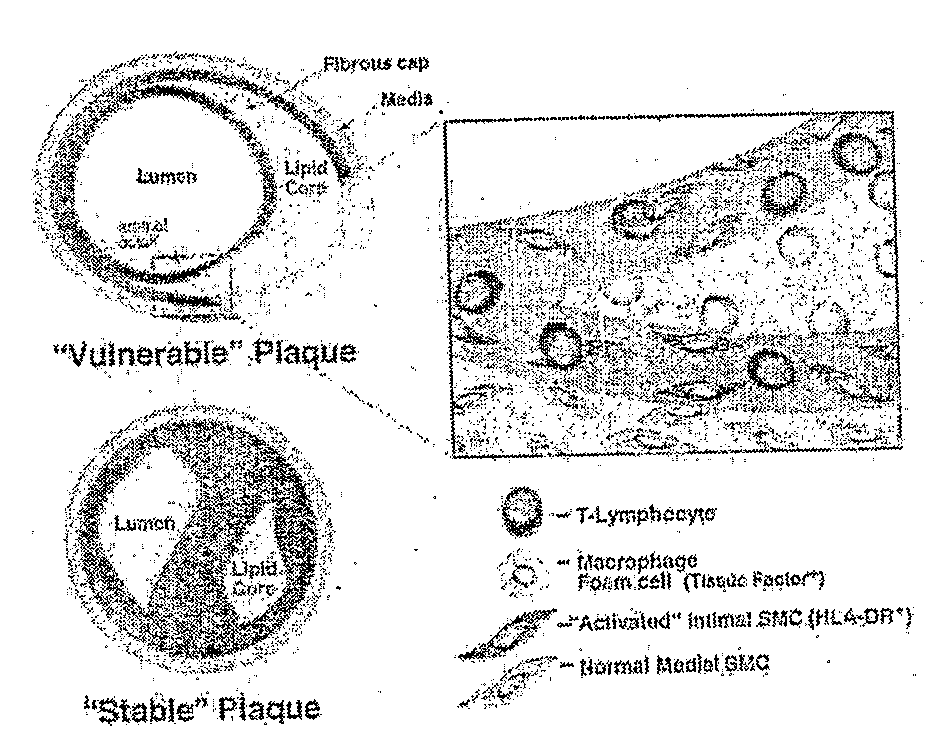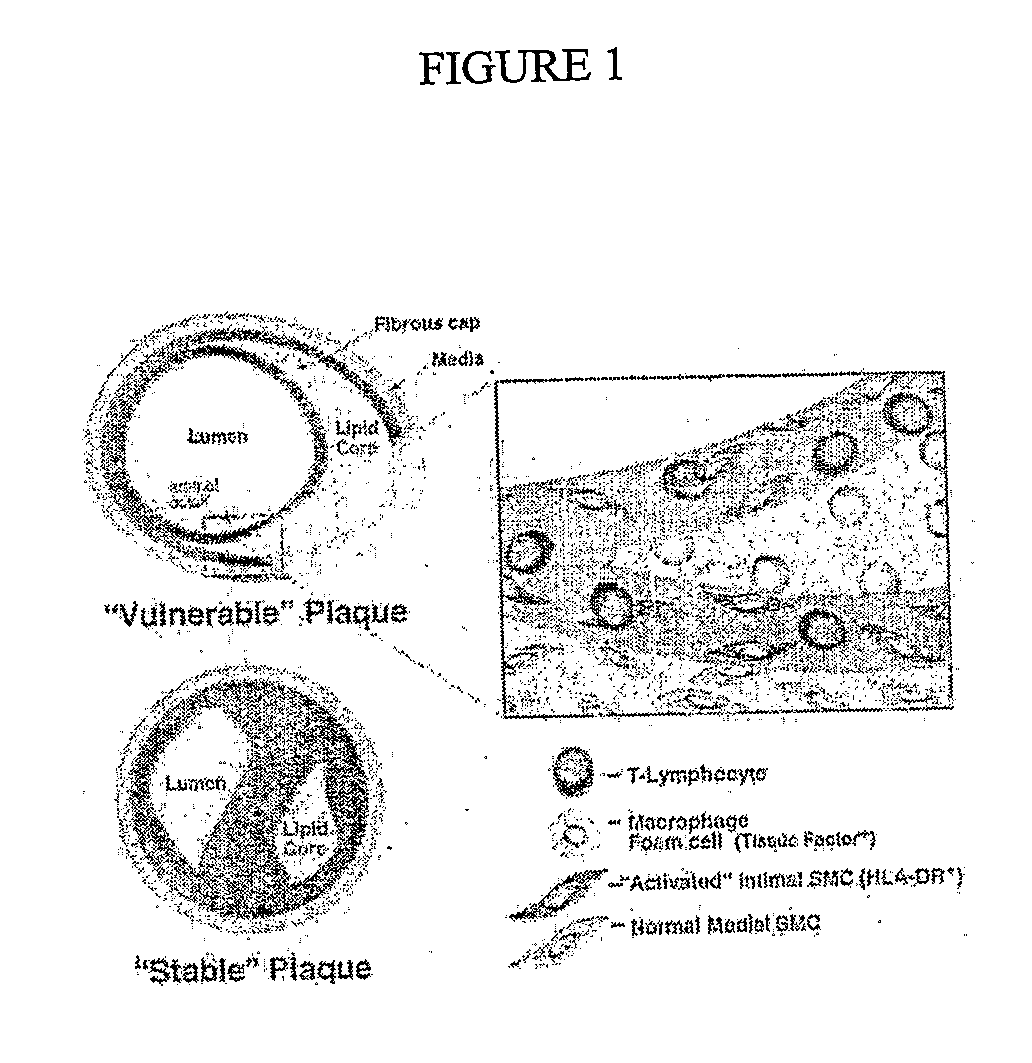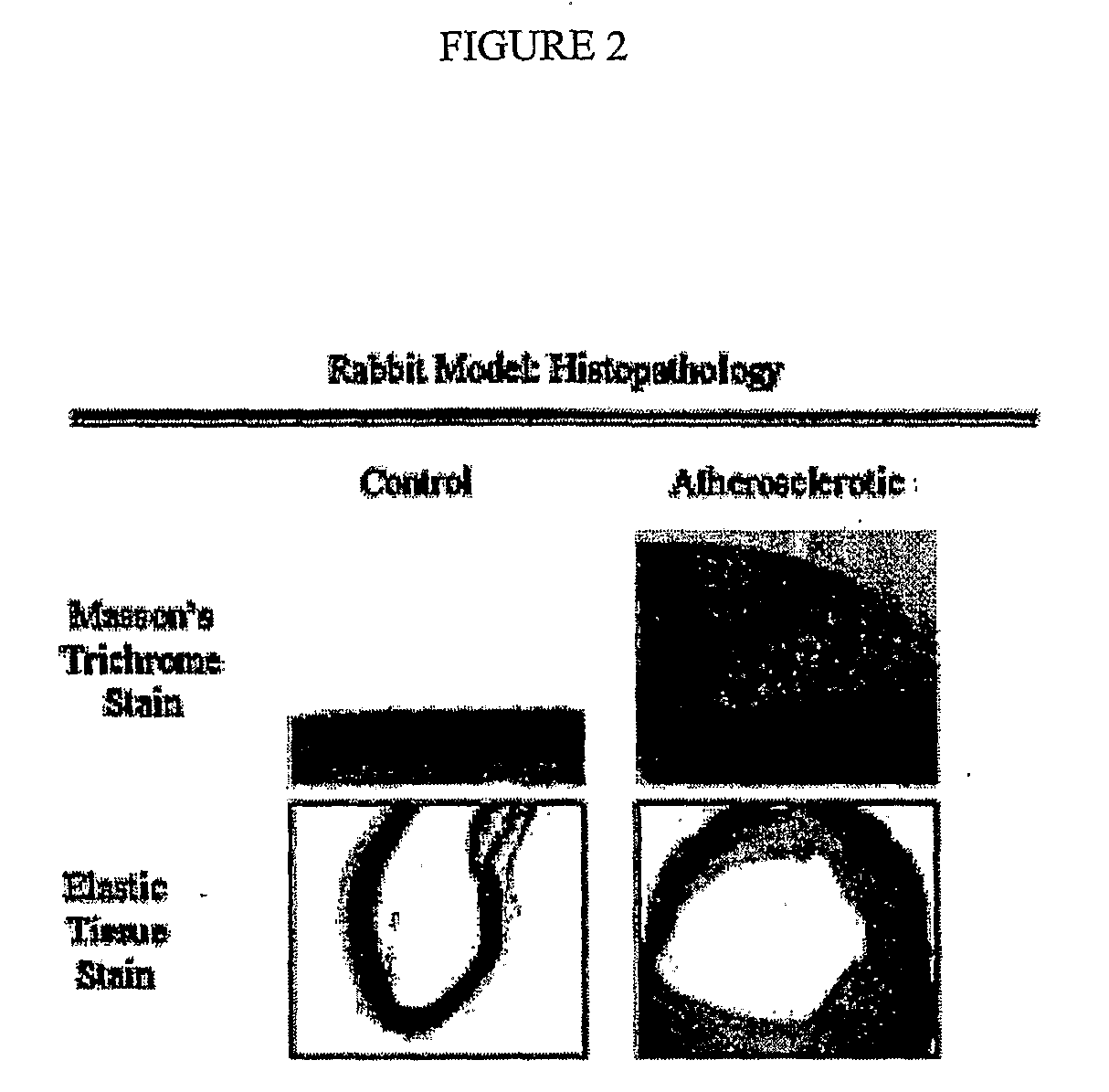Methods of Enhanced Detection and Therapy of Inflamed Tissues Using Immune Modulation
a technology of immune modulation and enhanced detection, applied in the field of enhanced detection and therapy of inflamed tissues using immune modulation, can solve the problems of heart attack, often death, mortality associated with coronary artery disease, etc., and achieve the effects of improving diagnosis and therapy, increasing diagnostic uptake, and increasing diagnostic selective targeting
- Summary
- Abstract
- Description
- Claims
- Application Information
AI Technical Summary
Benefits of technology
Problems solved by technology
Method used
Image
Examples
example 1
FDG-PET and Intravascular Catheter Imaging in Atherosclerotic Plaques
[0201]Male New Zealand white rabbits ranging from 2.5 to 3.0 kilograms in weight (Charles River Breeding Lab) were maintained on a 2% cholesterol-6% peanut oil diet (ICN) for 10 weeks. After 1 week on the peanut oil diet, the abdominal aorta was denuded of endothelium by a modified Baumgartner technique. Briefly, each animal was anesthetized with a mixture of ketamine and xylazine and the right femoral artery was isolated. Subsequently, a 4 F Fogarty embolectomy catheter was introduced via arteriotomy and advanced under fluoroscopic guidance to the level of the diaphragm. The balloon was then inflated to 3 psi (pounds per square inch) above balloon inflation pressure and three passes were made down the abdominal aorta with the inflated catheter. The femoral artery was subsequently ligated and the wound closed. This animal model system is standardly used in the art for the study of active atheromatous and vulnerable...
example 2
Accumulation of 99mTc-Chemotactic Peptide in Rabbit Aorta
[0205]Nuclear methods of targeting inflammatory cells can detect macrophage-rich atherosclerotic lesions. An animal model of atherosclerosis was generated in which macrophage-rich atherosclerotic plaques were induced in New Zealand rabbits by balloon de-endothelialization of the infra-diaphragmatic aorta followed by a high cholesterol diet. At 10 weeks, a 99mtechnetium radiolabeled derivative of bacterial chemotactic peptide CPRA was administered to 7 control rabbits, and to 7 rabbits in which aortic atherosclerotic lesions were induced. This peptide has been shown to bind avidly to leukocytes, with high specificity (Babich, J. W. et al, 1997). At 12 hours after the administration of the radiolabel, the live rabbits were imaged using single photon emission tomography (SPECT). Two investigators that were blinded to the status of the rabbits examined the images. A semi-quantitative scoring system was employed, in which a score o...
example 3
Preparation and Purification of Photosensitizer Compounds
[0206]A photosensitizer composition comprising chlorine6 (“ce6”) coupled to maleylated-albumin) was prepared for targeting to macrophages of a vulnerable plaque animal model system.
[0207]Four photosensitizer compositions were studied (i.e., two BSA-ce6 conjugates and their maleylated counterparts). The N-hydroxy succinimide (NHS) ester of ce6 was prepared by reacting approximately 1.5 equivalents of dicyclohexylcarbodiimide and approximately 1.5 equivalents of NHS with approximately 1 equivalent of ce6 (Porphyrin Products, Logan, Utah) in dry DMSO. After standing in the dark at room temperature for approximately 24 hours, the NHS ester was frozen in aliquots for further use. BSA (Sigma Chemical Co, St Louis, Mo.) (approximately 2×50 mg) was dissolved in NaHCO3 buffer (0.1 M, pH 9.3, approximately 3 ml), and approximately 30 μl and approximately 120 μl of ce6-NHS ester added to respective tubes with vortex mixing. After standin...
PUM
| Property | Measurement | Unit |
|---|---|---|
| thick | aaaaa | aaaaa |
| thick | aaaaa | aaaaa |
| energy triplet | aaaaa | aaaaa |
Abstract
Description
Claims
Application Information
 Login to View More
Login to View More - R&D
- Intellectual Property
- Life Sciences
- Materials
- Tech Scout
- Unparalleled Data Quality
- Higher Quality Content
- 60% Fewer Hallucinations
Browse by: Latest US Patents, China's latest patents, Technical Efficacy Thesaurus, Application Domain, Technology Topic, Popular Technical Reports.
© 2025 PatSnap. All rights reserved.Legal|Privacy policy|Modern Slavery Act Transparency Statement|Sitemap|About US| Contact US: help@patsnap.com



